|
John Tyman's Cultures in Context Series www.johntyman.com 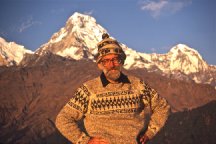
NEPAL Video Extracts Contents Part I Topic and Duration in Minutes and Seconds . |
|
John Tyman's Cultures in Context Series www.johntyman.com 
NEPAL Video Extracts Contents Part I Topic and Duration in Minutes and Seconds . |
|
01. Ramja Thanti and its Natural Setting (1’28”) 02. From Ploughing to Planting (4’19”) 03. Harvesting (3’19”) 04. Threshing and Winnowing (7’32”) 05. Farm Livestock (2’32”) 06. House Construction (3’33”) 07. Weddings: Dancing, Feasting and Gift-Giving (10’44”) 08. The Marriage Ceremony (14’56”) 09. Crafts and Caste (8’50”) 10. Domestic Chores in the Country (3’49”) 11. Public Education (5’15”) 12. School Assembly and Concert (10’23”) 13. Children’s Games (5’30”) 14. Businesses and Services (3’50”) 15. Religion : Private Prayers and Public Shrines (3’05”) |
|
www.johntyman.com/nepal |
Notes on Video Extracts
Part I
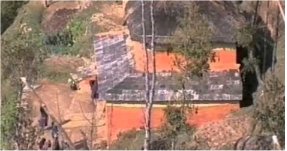 |
01. Ramja Thanti : Natural Setting. (1’28”) My friend’s village lay in the Hill Country in the middle of Nepal, a half-day’s walk from the city of Pokhara, Nepal’s third largest. From the village on a clear day you can see two of Nepal’s best known peaks -- Annapurna, on the left, and Machhapuchhare (Fishtail Mountain), to the right. The school and shops occupy the top of a ridge, and the farm houses are set into the terraced slopes below. The homes of the Brahman with their red plaster contrast with the whitewashed and slate roofed houses of the Gurung in a nearby valley. With steep slopes and increased clearing of native forests, landslides can be a problem, as they are in many parts of Nepal. |
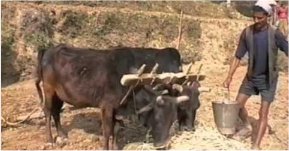 |
02. From Ploughing to Planting. (4’19”) In the Hill Country traditional farming techniques still prevail. The ploughman in the first clip was a mute, employed by the landowner to prepare his land for planting. The young woman was spreading manured compost and the ash from burnt leaves. The ploughman in the second clip was assisted by two women who broke up clumps of soil. When the farmer swopped his plough for a harrow, one of the women hurried home to collect their morning “lunch” (tea and popcorn) plus food and water for the cattle. The woman who remained, pulverized soil clumps and also removed stones. It took three people to plant corn: one to dig the furrow, one to plant the seed, and one to cover it. |
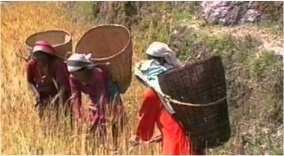 |
03. Harvesting. (3’19”) Machines have no place on these terraced hillsides, and harvesting is done by hand, by the farmer and his family (in this case that of my friend Gopal). Heads of wheat will be carried home for threshing, and the straw will be harvested also -- for animal bedding, thatching etc. The seed-bearing stems of the mustard plant will similarly be stored in a barn to await threshing in a day or two. |
 |
04.Threshing
and Winnowing. (7’32”) In the first sequence neighbours thresh
mustard seed over woven mats. In the second mustard sequence, Gopal’s mother
and father thresh mustard assisted by their daughters-in-law and, later,
by Gopal’s brother. The equipment required is minimal -- four feet,
two sticks and a floor surface capable of being swept. After the seed had
been swept into a pile, it was winnowed, and partially sieved, to separate
off dust as well as chaff.
Gopal’s brother Raj Kumur and a friend threshed the wheat initially but his father took over later. Rice was laboriously pounded in a hulling machine (“polished” to remove the outer husks as chaff). This was done in front of their old home (next to the round grinding stone used to make flour from wheat grain) using a treadmill powered by Gopal’s sister-in-law. After that it was winnowed and sorted -- and some sent back for reprocessing. |
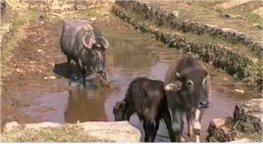 |
05. Farm Livestock. (2’32”) Chickens wander at will, even alongside Nepal’s few main roads: and, in the absence of improved pastures in the hill country, cattle, too, graze on common land and alongside tracks. The girl with the goat led it home past the school’s new toilet block (on a windy day) . Young children even care for large animals, finding them food and water. Rough pasture, often of poor quality, was also to be found on higher slopes, above cropland. Some buffaloes are brought up for the day: others spend most of their time here, till they are needed in the village below -- where they are given hay. |
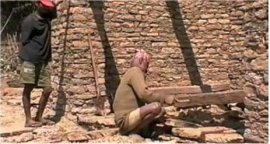 |
06. House Construction. (3’33”) The erection of buildings is man’s work. In this case a neighbour of Gopal was building a barn. Houses are built in much the same way, though their walls will be plastered over and painted inside and out.The stone slabs (and the beams to support the upper floor) are obtained locally, and the mud (for the mortar) is mixed on site. |
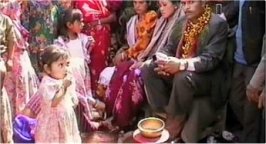 |
07.
Weddings : Dancing, Feasting and Gift-Giving. (10’44”)
The wedding was held at Tallogotamether, an hour or two’s walk from
Ramja Thanti. By the time we arrived the dancing was in full swing -- an
all-male affair which lasted most of the day. The musicians (from the tailor
caste) were paid, but not the dancers.
The bridal party was seated in front of the bride’s house, and the ceremony began with gift giving and the bestowal of blessings. A bride’s family does not have to pay a dowry as in India, but they do give her presents: and they bless her and the groom by marking them with tikas of coloured rice (scattering some of it), by washing the bride’s feet, and touching these with their heads in acts of honour and affection. Some money was also given to the groom. My gifts -- to bride the bride and the groom -- were presented by my friend Gopal. The wedding feast was provided by the bride’s family, who were Chetris, but it was cooked by Brahman priests to ensure that it would be pure. The guests sat in rows on terraced fields below the house, men separate from women. The dancing continued all this while, and during and after the wedding that followed, with a variety of performers trying their hand later. Eventually, later in the day, these same musicians (and some of the dancers) would line up at the ceremonial gateway to lead the procession home to the the groom’s village. |
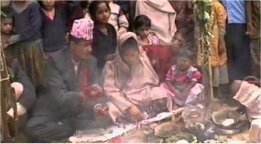 |
08.
The Marriage Ceremony. (14’56”) While the dancing continued,
the wedding ceremony in front of the bride’s home was presided over by
the groom’s family priest, assisted by that of the bride’s family, sitting
behind her. It included offerings of food to the gods by way of the
fire and many acts of ritual purification, prayer and blessing. The emotional
cords which bound the bride to her family were severed by her father.
She was distressed at the prospect of going away, and left briefly.
Her father had gifts for the groom -- whose presents for the bride were
in a case which, after it was blessed, was touched by the bride to signify
acceptance. Guided by their own priest, the girl’s parents ensured that
their daughter was properly purified, after which they will have placed
her hand in that of the groom (which I did not see).
There was a pause while the bride went inside to change into the clothes given to her by the groom, and some in the crowd returned to the dancing .The ceremony following her return involved still more prayers and promises, water from the Ganges, and -- standing in front of the bride’s home -- a symbolical offering to the gods of the ties that now bound the couple together. The priest then left and the bride waited at the gate to join the procession to her new home, during which she collapsed repeatedly -- a much distressed partner to an arranged marriage. |
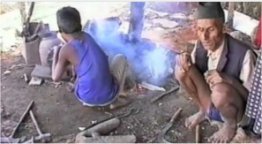 |
09.
Crafts and Caste. (8’50”) The caste system in Hindu societies still
determines who you may marry, what you may eat, who or what you may touch,
and what work you should do. Traditionally there were (in order of rank)
five groups -- priests (Brahmins), warriors, merchants, manual workers,
and untouchables. Most members of the priest and warrior castes are now
farmers, but manufacturing things is still the responsibility of the lowest
castes.
The tailor in Ramja Thanti had a workshop attached to his house: and a treadle-powered machine, which he threaded in the normal way. He had a tape measure but seldom needed to use it. He was making clothes for me to use in my school presentations. ( The writing on the wall to the right of the doorway was evidence of a recent election.) His “shop” was humble enough but few tailors in the world could have operated from a more spectacular site. Another tailor did most of his work on the road near his house, with an old machine. He lived in a settlement for “untouchables” just outside Ramja Thanti. His mother prayed for alms but also wanted to give me a present -- a topi (a cap) which I wore for the rest of my stay. A neighbour used an adze to shape the base of a model plough I had ordered. It was reworked by another man, a carpenter, who first made a miniature of the one he was to make for me. Later he swapped his adze for a chisel. The blacksmith’s son was in Grade 5 but is was Saturday and he spent much of his “free day”working -- in this case, in 40 minutes, finishing off a sickle, working on a blade that had been made the day before. His bellows were mechanized, but the techniques he used are ancient. |
 |
10.
Domestic Chores in the Country. (3’49”) Gopal’s wife, Bidhya, did
her laundry (including mine!) at a spring nearby. The water flowed into
a pond where cattle came for water and where ducks felt at home. The spring
was the site of a typical “rest station” on a major trail and the wooden
post in the pond commemorated the union of the traditional
banyan (supposedly male) and pipal (female) trees planted long ago on either
side, and “married” in a ceremony with a band.
Platters and cups were washed outside the house, alongside the compost heap on which was deposited ash from the fire as well as organic material. Bidhya used handfuls of ash as an abrasive in cleaning utensils: and the water, after use, drained into the compost. Firewood (and some animal fodder) is collected from the high country, from the few woodlands that remain -- usually by children on their day off, Saturday. Stone structures like that in the rear allow porters to rest heavy loads but only one child makes use of it. |
 |
11. Public Education. (5’15”) The grounds of the school in Ramja Thanti lie on the top of the ridge and, on a clear day, they offer a spectacular view of the Himalayas.The children all walked to school, some over great distances from other valleys. (On this day my friend Gopal tried to “organize” their arrival for the camera.) The classrooms are long and narrow, built of stone, with few windows and no artificial lighting. Brief excerpts from two lessons are reproduced here: one in maths, the other a language class. Traditionally here, learning has been by rote, with everything committed to memory. |
 |
12. School Assembly and Concert. (10’23”) A special assembly was organized in my honor (because I had raised money in Australia for the construction of a toilet block). There were speeches, of course, and I received traditional blessings, but there were also songs and dances. In the first dance traditional girl meets traditional boy, but in the second one he says to her “Why tell me you’re a good traditional girl when you dress the way you do?” In the third dance a former student dances, and the choir sings, of their mixed feelings that their country is being “developed”. The assembly ended with the distribution of sweets I had brought from Australia, supplemented by others bought locally. |
 |
13.
Children’s Games. (5’30”) The young man who juggled the bamboo
(in a game known as “dandibiawo”) had stopped on his way to school to show
me how it was played. He put down his books and removed his shoes, retrieving
them when he had finished.
In the recreational time slot at a neighbouring primary school the children played two rounds of “Cat and Mouse” (in which one child was supposed to squeak and the other to meow) and then a lengthy game of “Kapardi” in which two teams were selected and the boundary between their territories clearly marked. Children took it in turns to invade the territory of their opponents and tag one of them without getting caught themselves. They were expected to take a breath as they crossed the line, start chanting, and continue doing so while trying to tag an opponent before they ran out of breath, and had to retreat. Those who failed in their mission were progressively eliminated and the winners applauded at the end. |
 |
14.
Businesses and Services. (3’50”) The headmaster of the school had
popped out for a cup of tea. He was served by the daughter of the teashop’s
owner because her mother was considered “unclean” for four days (as she
was having her monthly period).
The tailor’s workshop was next door and the sound of his machine could be heard from the tea house. He was sewing up waistcoats with blue linings for me. His “shop” was not much bigger than a cupboard! The general store marketed a wide range of goods, including the sweets bought by children. The shopkeeper and her family slept in the space at the end of the counter. The vet had a shelf full of animal medicines and such like in the corner of his office, the walls of which were adorned with government notices and posters -- together with portraits of the king and queen of Nepal (since deceased). |
 |
15.
Religion: Private Prayers and Public Shrines. (3’05”) Practicing
Hindu males (and females after marriage) are expected to pray each day
before they eat their first meal; and again in the evening. This man spent
20 minutes in prayer, kneeling on the pathway in front of my friend’s house.
He can neither read nor write but can recite in Sanskrit the whole of the
Ramayana and Mahabharata epics without a break. The thread around his neck
indicates that he is a Brahman.
Shrines abound, at significant places. This one, high in the forest, is the scene of an annual water festival. (Also see Videos 07 and 08 for weddings: and the coverage of naming ceremonies, puja, and exorcism in frames 447-474 of the Nepal photo journal.) |
![]()
Text, photos, videos and recordings
by John Tyman
Intended for Educational Use
Only.
Contact Dr. John Tyman at johntyman2@gmail.com
for more information regarding
licensing.
![]()
www.hillmanweb.com
Photo processing, Web page layout,
formatting and hosting by
William
Hillman ~ Brandon, Manitoba ~ Canada